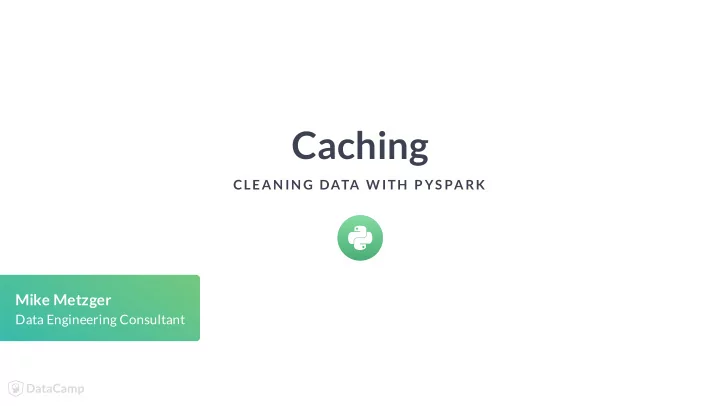

Caching CLEAN IN G DATA W ITH P YS PARK Mike Metzger Data Engineering Consultant
What is caching? Caching in Spark: Stores DataFrames in memory or on disk Improves speed on later transformations / actions Reduces resource usage CLEANING DATA WITH PYSPARK
Disadvantages of caching Very large data sets may not �t in memory Local disk based caching may not be a performance improvement Cached objects may not be available CLEANING DATA WITH PYSPARK
Caching tips When developing Spark tasks: Cache only if you need it Try caching DataFrames at various points and determine if your performance improves Cache in memory and fast SSD / NVMe storage Cache to slow local disk if needed Use intermediate �les! Stop caching objects when �nished CLEANING DATA WITH PYSPARK
Implementing caching Call .cache() on the DataFrame before Action voter_df = spark.read.csv('voter_data.txt.gz') voter_df.cache().count() voter_df = voter_df.withColumn('ID', monotonically_increasing_id()) voter_df = voter_df.cache() voter_df.show() CLEANING DATA WITH PYSPARK
More cache operations Check .is_cached to determine cache status print(voter_df.is_cached) True Call .unpersist() when �nished with DataFrame voter_df.unpersist() CLEANING DATA WITH PYSPARK
Let's Practice! CLEAN IN G DATA W ITH P YS PARK
Improve import performance CLEAN IN G DATA W ITH P YS PARK Mike Metzger Data Engineering Consultant
Spark clusters Spark Clusters are made of two types of processes Driver process Worker processes CLEANING DATA WITH PYSPARK
Import performance Important parameters: Number of objects (Files, Network locations, etc) More objects better than larger ones Can import via wildcard airport_df = spark.read.csv('airports-*.txt.gz') General size of objects Spark performs better if objects are of similar size CLEANING DATA WITH PYSPARK
Schemas A well-de�ned schema will drastically improve import performance Avoids reading the data multiple times Provides validation on import CLEANING DATA WITH PYSPARK
How to split objects Use OS utilities / scripts (split, cut, awk) split -l 10000 -d largefile chunk- Use custom scripts Write out to Parquet df_csv = spark.read.csv('singlelargefile.csv') df_csv.write.parquet('data.parquet') df = spark.read.parquet('data.parquet') CLEANING DATA WITH PYSPARK
Let's practice! CLEAN IN G DATA W ITH P YS PARK
Cluster sizing tips CLEAN IN G DATA W ITH P YS PARK Mike Metzger Data Engineering Consultant
Con�guration options Spark contains many con�guration settings These can be modi�ed to match needs Reading con�guration settings: spark.conf.get(<configuration name>) Writing con�guration settings spark.conf.set(<configuration name>) CLEANING DATA WITH PYSPARK
Cluster Types Spark deployment options: Single node Standalone Managed YARN Mesos Kubernetes CLEANING DATA WITH PYSPARK
Driver T ask assignment Result consolidation Shared data access Tips: Driver node should have double the memory of the worker Fast local storage helpful CLEANING DATA WITH PYSPARK
Worker Runs actual tasks Ideally has all code, data, and resources for a given task Recommendations: More worker nodes is often better than larger workers T est to �nd the balance Fast local storage extremely useful CLEANING DATA WITH PYSPARK
Let's practice! CLEAN IN G DATA W ITH P YS PARK
Performance improvements CLEAN IN G DATA W ITH P YS PARK Mike Metzger Data Engineering Consultant
Explaining the Spark execution plan voter_df = df.select(df['VOTER NAME']).distinct() voter_df.explain() == Physical Plan == *(2) HashAggregate(keys=[VOTER NAME#15], functions=[]) +- Exchange hashpartitioning(VOTER NAME#15, 200) +- *(1) HashAggregate(keys=[VOTER NAME#15], functions=[]) +- *(1) FileScan csv [VOTER NAME#15] Batched: false, Format: CSV, Location: InMemoryFileIndex[file:/DallasCouncilVotes.csv.gz], PartitionFilters: [], PushedFilters: [], ReadSchema: struct<VOTER NAME:string> CLEANING DATA WITH PYSPARK
What is shuf�ing? Shuf�ing refers to moving data around to various workers to complete a task Hides complexity from the user Can be slow to complete Lowers overall throughput Is often necessary, but try to minimize CLEANING DATA WITH PYSPARK
How to limit shuf�ing? Limit use of .repartition(num_partitions) Use .coalesce(num_partitions) instead Use care when calling .join() Use .broadcast() May not need to limit it CLEANING DATA WITH PYSPARK
Broadcasting Broadcasting : Provides a copy of an object to each worker Prevents undue / excess communication between nodes Can drastically speed up .join() operations Use the .broadcast(<DataFrame>) method from pyspark.sql.functions import broadcast combined_df = df_1.join(broadcast(df_2)) CLEANING DATA WITH PYSPARK
Let's practice! CLEAN IN G DATA W ITH P YS PARK
Recommend
More recommend